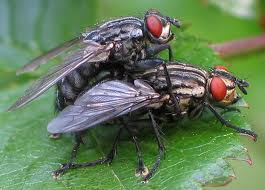Reproduction
Like all species in the order Diptera, Sarcophaga
crassipalpis undergoes a life cycle called complete
metamorphosis, which includes four stages: egg, larva, pupa, and
adult (2013. Fly...). Spring marks the typical mating season, and
fertilized eggs develop and hatch inside the female (Kgware et
al.). Once they reach the larval stage, they are most commonly
deposited into vertebrate remains or manure, which they will
feed off of for nearly a week. When they are ready to pupate,
the larvae wriggle away from the food source. The pupal stage
lasts about ten days, during which the pupal body progressively
darkens as development proceeds (Diaz & Kaufman 2011). It is
during this stage that diapause occurs (see
Form and Function). Adults are
able to reproduce about once every ten days, but the average
lifespan is only around twenty days (Wessels et al. 2011). 
Because of their short lifespan,
effective reproduction is imperative. On average, females mate
within the first two to four days of adulthood (Hahn et al. 2008).
However, all female flies undergo oogenesis – the process of
creating eggs – at approximately the same time regardless of whether
they have been exposed to males. The size and mass of eggs is also
independent of the mating process. Still, mating is more
advantageous as females who mate produce a quantity of ten percent
more eggs than those who do not (Hahn et al. 2008). This
demonstrates the importance of the mating ritual in the flesh fly
life cycle. In fact, almost all of a Sarcophaga’s life is
spent preparing for and engaging in reproduction.
The nature of S. crassipalpis raises several reproductive
constraints. For instance, the female’s search for carrion to
sustain her larvae is not always an easy one. The quick
decomposition of organic matter combined with interspecific
competition make animal remains an unstable, sometimes unavailable
environment for the flesh fly (Hahn et al. 2008). Furthermore,
most females in the wild (as opposed to in laboratory settings) lay
only one clutch of eggs due to their short lifespan (Wessels et
al. 2011). This increases the pressure to find an adequate location
to drop her larvae as she usually only has one chance. Females also
require an external source of dietary protein in order to undergo
oogenesis (Wessels et al. 2011). In environments where resources
are scarce, reproduction is often impossible. Unlike many other
species of flies, S. crassipalpis is unable to reallocate
non-reproductive resources; however, they are able to produce eggs
for almost two weeks after they reach adulthood, which is longer
than the average fly. Luckily, oogenesis proceeds at the same rate
regardless of when a female receives a protein source, so even flies
with scant resources usually have time to seek out an adequate meal
(Wessels et al. 2011).
Although females carry the bulk of the burden of reproduction, males
also face conflict when it comes to passing on their genes. Both the
physiology and the behavior of the male S. crassipalpis
reflect his struggle to find a mate. As in many animal species, the
male is significantly larger than the female. Males also possess
strong front legs which allow them to more easily dominate females
during the mating process (Diaz & Kaufman 2011). (For more on S.
crassipalpis physiology, see Form
and Function). The male also exhibits behaviors that
indicate the significance of his role in reproduction. Males
visually evaluate other insects that come nearby and handle threats
quickly by attacking both males of their own species and insects of
other species. While it is unclear whether this is an innate or a
learned behavior, it demonstrates the response of male flesh flies
to reproductive obstacles (Paquette et al. 2008).
Besides the territoriality that males exhibit toward other species
of Insecta, S. crassipalpis interacts with a variety of other
species. Follow the link to learn more about flesh fly
Interactions.